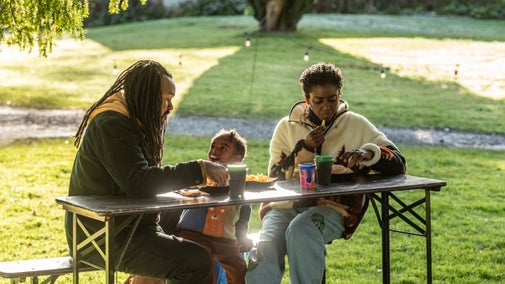
Caring for nature
Learn about our work on nature, climate and sustainability, and find out what you can do to make a difference.

Discover how we’re part of the global fight against climate change, the challenges we face with shifting weather patterns and what we’re doing to care for historic houses and landscapes in our care.
Read about our Climate Action Transition Plan and our commitment to reach net zero carbon by 2030.

In the UK, 2.5 billion single-use coffee cups are discarded every year– this is creating waste that's harmful for nature, wildlife and the climate. To reduce our impact on the environment, we've decided to phase out the use of single-use cups across our places by 2026. Find out how you can support this change.

Discover how some of the special places in our care are harnessing the power of the sun to generate electricity and reduce their carbon footprints.

Discover which of the places in our care generate their own hydroelectricity, from a 19th-century 'smart home' in Northumberland to a state-of-the-art water turbine in scenic Snowdonia.

We’re tackling the threats of a changing coastline to safeguard the places you love. Find out how our teams are adapting their approach to our shifting shores.

Find out how we're planting and establish 20 million trees that will absorb carbon and help tackle climate change.
Trees provide vital habitats for a range of wildlife and are one of the best natural defences against climate change. This is why we're aiming to plant and establish 20 million trees by 2030. Donate to Plant a Tree and make a difference.

Discover the vital ways peat supports the environment, from carbon store to archaeological record, and see some of our key projects protecting and restoring the peatland in our care.

We've committed to going peat free as an organisation, and all the plants we grow, buy and sell are potted in peat-free compost. Hear from our team of gardening experts and discover top tips for peat-free gardening in your green space.

We're part of the global fight against climate change. It is the single biggest threat to the precious landscapes and historic houses we care for. Our teams are adapting to the many effects of climate change, from managing the impact of rising sea levels at Mount Stewart to reducing carbon emissions at Wimpole, we're working hard to protect the places in our care for everyone, for ever.
Conservation work at Wicken Fen in Cambridgeshire is helping vital wetland habitats adapt to climate change. Increasing the flow of water around the fens will support wildlife during the winter and help peat soils store more carbon. Find out about this and other measures to protect the landscape.

What impact is climate change having on the wildlife and habitats of the Mount Stewart estate?

Discover how the National Trust is tackling the impact of climate change at Ham House.

Find out about how Wallington benefited from the DEFRA Green Recovery Challenge Fund, including some fascinating archaeological discoveries unearthed by ‘LiDAR’ technology.

This exciting new curation is a sympathetic revitalisation of a space within the Grade I listed garden. With a design of our time by three-time RHS Chelsea award-winner, Joe Perkins, this is the first major renovation project since the garden came under National Trust care and represents a significant and pioneering moment for Sheffield Park and Garden.
We’re working on a long-term project in the Conwy catchment to tackle climate change and reduce extreme flooding for the benefit of nature, wildlife and people.
Killerton’s estate is an important wildlife haven, but is threatened by climate change. Thanks to the Green Recovery Challenge Fund, projects have been completed to protect its grounds.
Discover how Wimpole is using the Green Recovery Fund to help create and restore habitats, support solutions to tackle climate change and connect people with nature.
Look back on the Skell Valley Project which strived to create a sustainable future for the Skell Valley in North Yorkshire.
Find out how you can reduce your carbon footprint, reduce waste and help wildlife on your doorstep. Even the smallest changes can make a big difference for nature and the climate.
From tips on saving water to combatting plastic pollution, learn more about our work to protect precious coasts and rivers for wildlife and people, and what you can do to help.

The climate crisis can be overwhelming, but small actions can help make big changes. Find out how you can play your part with ideas from planting trees to going peat-free.

Find out how you can travel to the places in our care by train, bus, bike or on foot, helping you to save money and care for the environment.

We are very grateful to the funders and partners who support our work on climate change, including Defra’s Green Recovery Challenge Fund, the European Climate Foundation, the European Regional Development Fund, the Environment Agency, HSBC UK, the National Lottery Heritage Fund, Natural Resources Wales, Northern Ireland’s Department for Agriculture, Environment and Rural Affairs, the Northern Powerhouse, players of People’s Postcode Lottery, The Royal Oak Foundation, UK Research and Innovation, the Welsh Government and the Wolfson Foundation, as well as many other generous people and organisations.
With support from the Government’s Green Recovery Challenge Fund, we're looking for ways to protect our environment and combat climate change. Find out more about the work we're doing.

Discover more about the National Trust’s role at COP26 in Glasgow and how you can help tackle the climate crisis.

Learn about the six climate and nature-based targets discussed at the Climate and Land Summit and how the solutions are being applied at National Trust places.


Learn about our work on nature, climate and sustainability, and find out what you can do to make a difference.